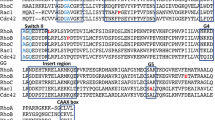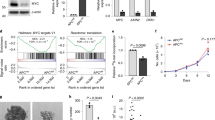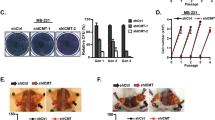Abstract
Recent genetic investigations have established that RhoB gain-of-function is sufficient to mediate the antitransforming effects of farnesyltransferase inhibitors (FTIs) in H-Ras-transformed fibroblast systems. In this study, we addressed the breadth and mechanism of RhoB action in epithelial cells transformed by oncoproteins which are themselves insensitive to FTI inactivation. Rat intestinal epithelial (RIE) cells transformed by activated K-Ras or Rac1 were highly sensitive to FTI-induced actin reorganization and growth inhibition, despite the inability of FTI to block prenylation of either K-Ras or Rac1. Ectopic expression of the geranylgeranylated RhoB isoform elicited in cells by FTI treatment phenocopied these effects. Analysis of RhoB effector domain mutants pointed to a role for PRK, a Rho effector kinase implicated in the physiological function of RhoB in intracellular receptor trafficking, and these findings were supported further by experiments in a fibroblast system. We propose that FTIs recruit the antioncogenic RhoB protein in the guise of RhoB-GG to interfere with signaling by pro-oncogenic Rho proteins, possibly by sequestering common exchange factors or effectors such as PRK that are important for cell transformation.
This is a preview of subscription content, access via your institution
Access options
Subscribe to this journal
Receive 50 print issues and online access
$259.00 per year
only $5.18 per issue
Buy this article
- Purchase on Springer Link
- Instant access to full article PDF
Prices may be subject to local taxes which are calculated during checkout








Similar content being viewed by others
References
Adamson P, Paterson HF and Hall A . (1992). J. Cell Biol., 119, 617–627.
Adjei AA . (2001). J. Nat. Cancer Inst., 93, 1062–1074.
Balendran A, Casamayor A, Deak M, Paterson A, Gaffney P, Currie R, Downes CP and Alessi DR . (1999). Curr. Biol., 9, 393–404.
Cox AD . (2001). Drugs, 61, 723–732.
Cryns VL, Byun Y, Rana A, Mellor H, Lustig KD, Ghanem L, Parker PJ, Kirschner MW and Yuan J . (1997). J. Biol. Chem., 272, 29449–29453.
Du W, Lebowitz P and Prendergast GC . (1999a). Mol. Cell. Biol., 19, 1831–1840.
Du W, Lebowitz PF and Prendergast GC . (1999b). Cancer Res., 59, 2059–2063.
Du W, Liu A and Prendergast GC . (1999c). Cancer Res., 59, 4808–4812.
Du W and Prendergast GC . (1999). Cancer Res., 59, 5924–5928.
Flynn P, Mellor H, Casamassima A and Parker PJ . (2000). J. Biol. Chem., 275, 11064–11070.
Gampel A, Parker PJ and Mellor H . (1999). Curr. Biol., 9, 955–958.
Hawley RG, Lieu FH, Fong AZ and Hawley TS . (1994). Gene Ther., 1, 136–138.
Khosravi-Far R, Solski PA, Clark GJ, Kinch MS and Der CJ . (1995). Mol. Cell. Biol., 15, 6443–6453.
Koh H, Lee KH, Kim D, Kim S, Kim JW and Chung J . (2000). J. Biol. Chem., 275, 34451–34458.
Kohl NE, Mosser SD, deSolms SJ, Giuliani EA, Pompliano DL, Graham SL, Smith RL, Scolnick EM, Oliff A and Gibbs JB . (1993). Science, 260, 1934–1937.
Kohl NE, Omer CA, Conner MW, Anthony NJ, Davide JP, deSolms SJ, Giuliani EA, Gomez RP, Graham SL, Hamilton K, Handt LK, Hartman GD, Koblan KS, Kral AM, Miller PJ, Mosser SD, O'Neill TJ, Rands E, Schaber MD, Gibbs JB and Oliff A . (1995). Nat. Med., 1, 792–797.
Lebowitz P, Casey PJ, Prendergast GC and Thissen J . (1997a). J. Biol. Chem., 272, 15591–15594.
Lebowitz P, Du W and Prendergast GC . (1997b). J. Biol. Chem., 272, 16093–16096.
Lebowitz PF, Davide JP and Prendergast GC . (1995). Mol. Cell. Biol., 15, 6613–6622.
Lebowitz PF, Sakamuro D and Prendergast GC . (1997c). Cancer Res., 57, 708–713.
Lerner EC, Zhang TT, Knowles DB, Qian YM, Hamilton AD and Sebti SM . (1997). Oncogene, 15, 1283–1288.
Liao J, Hodge C, Meyer D, Ho PS, Rosenspire K and Schwartz J . (1997). J. Biol. Chem., 272, 25951–25958.
Liu A-X, Cerniglia GJ, Bernhard EJ and Prendergast GC . (2001a). Proc. Natl. Acad. Sci. USA, 98, 6192–6197.
Liu A-X, Du W, Liu J-P, Jessell TM and Prendergast GC . (2000). Mol. Cell. Biol., 20, 6105–6113.
Liu A-X and Prendergast GC . (2000). FEBS Lett., 481, 205–208.
Liu, A-X, Rane N, Liu J-P, Prendergast GC . (2001b). Mol. Cell. Biol., 21, 6906–6912.
Mellor J, Flynn P, Nobes CD, Hall A and Parker PJ . (1998). J. Biol. Chem., 273, 4811–4814.
Olson MF, Paterson HF and Marshall CJ . (1998). Nature, 394, 295–299.
Prendergast GC . (2000a). Curr. Opin. Cell Biol., 12, 166–173.
Prendergast GC . (2000b). Lancet Oncol., 1, 73.
Prendergast GC . (2001). Nature Rev. Cancer, 1, 162–168.
Prendergast GC, Davide JP, deSolms SJ, Giuliani E, Graham S, Gibbs JB, Oliff A and Kohl NE . (1994). Mol. Cell. Biol., 14, 4193–4202.
Prendergast GC and Oliff A . (2000). Sem. Cancer Biol., 10, 443–452.
Prendergast GC and Rane N . (2001). Expert Opin. Investig. Drugs, 10, 2105–2116.
Qiu RG, Chen J, McCormick F and Symons M . (1995). Proc. Natl. Acad. Sci. USA, 92, 11781–11785.
Rowell CA, Kowalczyk JJ, Lewis MD and Garcia AM . (1997). J. Biol. Chem., 272, 14093–14097.
Rowinsky EK, Windle JJ and Von Hoff DD . (1999). J. Clin. Oncol., 17, 3631–3652.
Sahai E, Alberts AS and Treisman R . (1998). EMBO J., 17, 1350–1361.
Sebti SM and Hamilton AD . (2000). Oncogene, 19, 6584–6593.
Suzuki N, Urano J and Tamanoi F . (1998). Proc. Natl. Acad. Sci. USA, 95, 15356–15361.
Takahashi M, Mukai H, Toshimori M, Miyamoto M and Ono Y . (1998). Proc. Natl. Acad. Sci. USA, 95, 11566–11571.
van Golen KL, Bao LW, DeVito MM, Wu Z-F, Prendergast GC and Merajver SD . (2002). Mol. Cancer Ther., 1, 575–583.
van Golen KL, Davies S, Wu ZF, Wnag Y, Bucana CD, Root H, Chandrasekharappa S, Strawderman M, Ethier SP and Merajver SD . (1999). Clin. Cancer Res., 5, 2511–2519.
van Golen KL, Wu Z-F, Qiao X, Bao L and Merajver SD . (2000a). Neoplasia, 2, 418–425.
van Golen KL, Wu Z-F, Qiao XT, Bao LW and Merajver SD . (2000b). Cancer Res., 60, 5832–5838.
Whyte DB, Kirschmeier P, Hockenberry TN, Nunez-Olivia I, James L, Catino JJ, Bishop WR and Pai JK . (1997). J. Biol. Chem., 272, 14459–14464.
Zohar M, Teramoto H, Katz B-Z, Yamada KM and Gutkind JS . (1998). Oncogene, 17, 991–998.
Acknowledgements
We thank Adrienne Cox for providing RIE cells, Channing Der for the human K-Ras4B-V12 cDNA, Alan Hall for Rac1-Q61L cDNA, and Diane Sharp and Jeffrey Faust for performing flow cytometry. NR was supported by a postdoctoral research grant from the US Army Breast Cancer Research Program. This work was supported in part by NIH Grant CA82222 (GCP).
Author information
Authors and Affiliations
Corresponding author
Rights and permissions
About this article
Cite this article
Zeng, PY., Rane, N., Du, W. et al. Role for RhoB and PRK in the suppression of epithelial cell transformation by farnesyltransferase inhibitors. Oncogene 22, 1124–1134 (2003). https://doi.org/10.1038/sj.onc.1206181
Received:
Revised:
Accepted:
Published:
Issue Date:
DOI: https://doi.org/10.1038/sj.onc.1206181
Keywords
This article is cited by
-
Protein prenylation: unique fats make their mark on biology
Nature Reviews Molecular Cell Biology (2016)
-
RhoB controls endothelial cell morphogenesis in part via negative regulation of RhoA
Vascular Cell (2012)
-
RhoB facilitates c-Myc turnover by supporting efficient nuclear accumulation of GSK-3
Oncogene (2006)
-
Protein and m-RNA expression of farnesyl-transferases, RhoA and RhoB in rat liver hepatocytes: action of perillyl alcohol and vitamin A in vivo.
Journal of Biomedical Science (2005)



